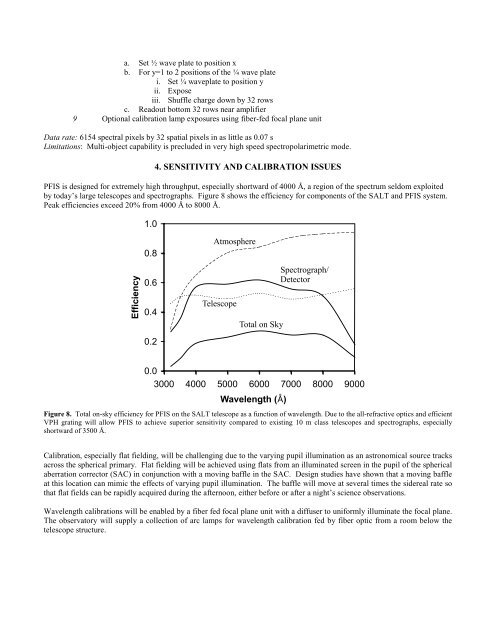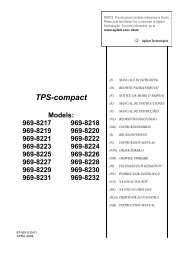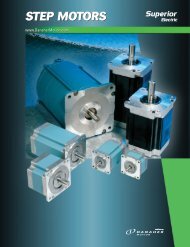The Prime Focus Imaging Spectrograph for the Southern - Space ...
The Prime Focus Imaging Spectrograph for the Southern - Space ...
The Prime Focus Imaging Spectrograph for the Southern - Space ...
Create successful ePaper yourself
Turn your PDF publications into a flip-book with our unique Google optimized e-Paper software.
a. Set ½ wave plate to position x<br />
b. For y=1 to 2 positions of <strong>the</strong> ¼ wave plate<br />
i. Set ¼ waveplate to position y<br />
ii. Expose<br />
iii. Shuffle charge down by 32 rows<br />
c. Readout bottom 32 rows near amplifier<br />
9 Optional calibration lamp exposures using fiber-fed focal plane unit<br />
Data rate: 6154 spectral pixels by 32 spatial pixels in as little as 0.07 s<br />
Limitations: Multi-object capability is precluded in very high speed spectropolarimetric mode.<br />
4. SENSITIVITY AND CALIBRATION ISSUES<br />
PFIS is designed <strong>for</strong> extremely high throughput, especially shortward of 4000 Å, a region of <strong>the</strong> spectrum seldom exploited<br />
by today’s large telescopes and spectrographs. Figure 8 shows <strong>the</strong> efficiency <strong>for</strong> components of <strong>the</strong> SALT and PFIS system.<br />
Peak efficiencies exceed 20% from 4000 Å to 8000 Å.<br />
Figure 8. Total on-sky efficiency <strong>for</strong> PFIS on <strong>the</strong> SALT telescope as a function of wavelength. Due to <strong>the</strong> all-refractive optics and efficient<br />
VPH grating will allow PFIS to achieve superior sensitivity compared to existing 10 m class telescopes and spectrographs, especially<br />
shortward of 3500 Å.<br />
Calibration, especially flat fielding, will be challenging due to <strong>the</strong> varying pupil illumination as an astronomical source tracks<br />
across <strong>the</strong> spherical primary. Flat fielding will be achieved using flats from an illuminated screen in <strong>the</strong> pupil of <strong>the</strong> spherical<br />
aberration corrector (SAC) in conjunction with a moving baffle in <strong>the</strong> SAC. Design studies have shown that a moving baffle<br />
at this location can mimic <strong>the</strong> effects of varying pupil illumination. <strong>The</strong> baffle will move at several times <strong>the</strong> sidereal rate so<br />
that flat fields can be rapidly acquired during <strong>the</strong> afternoon, ei<strong>the</strong>r be<strong>for</strong>e or after a night’s science observations.<br />
Wavelength calibrations will be enabled by a fiber fed focal plane unit with a diffuser to uni<strong>for</strong>mly illuminate <strong>the</strong> focal plane.<br />
<strong>The</strong> observatory will supply a collection of arc lamps <strong>for</strong> wavelength calibration fed by fiber optic from a room below <strong>the</strong><br />
telescope structure.








